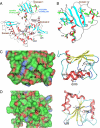Mso1p regulates membrane fusion through interactions with the putative N-peptide-binding area in Sec1p domain 1
- PMID: 20181830
- PMCID: PMC2854094
- DOI: 10.1091/mbc.e09-07-0546
Mso1p regulates membrane fusion through interactions with the putative N-peptide-binding area in Sec1p domain 1
Abstract
Sec1p/Munc18 (SM) family proteins regulate SNARE complex function in membrane fusion through their interactions with syntaxins. In addition to syntaxins, only a few SM protein interacting proteins are known and typically, their binding modes with SM proteins are poorly characterized. We previously identified Mso1p as a Sec1p-binding protein and showed that it is involved in membrane fusion regulation. Here we demonstrate that Mso1p and Sec1p interact at sites of exocytosis and that the Mso1p-Sec1p interaction site depends on a functional Rab GTPase Sec4p and its GEF Sec2p. Random and targeted mutagenesis of Sec1p, followed by analysis of protein interactions, indicates that Mso1p interacts with Sec1p domain 1 and that this interaction is important for membrane fusion. In many SM family proteins, domain 1 binds to a N-terminal peptide of a syntaxin family protein. The Sec1p-interacting syntaxins Sso1p and Sso2p lack the N-terminal peptide. We show that the putative N-peptide binding area in Sec1p domain 1 is important for Mso1p binding, and that Mso1p can interact with Sso1p and Sso2p. Our results suggest that Mso1p mimics N-peptide binding to facilitate membrane fusion.
Figures







Similar articles
-
A conserved regulatory mode in exocytic membrane fusion revealed by Mso1p membrane interactions.Mol Biol Cell. 2013 Feb;24(3):331-41. doi: 10.1091/mbc.E12-05-0415. Epub 2012 Nov 28. Mol Biol Cell. 2013. PMID: 23197474 Free PMC article.
-
Sec1p and Mso1p C-terminal tails cooperate with the SNAREs and Sec4p in polarized exocytosis.Mol Biol Cell. 2011 Jan 15;22(2):230-44. doi: 10.1091/mbc.E10-07-0592. Epub 2010 Nov 30. Mol Biol Cell. 2011. PMID: 21119007 Free PMC article.
-
Molecular interactions position Mso1p, a novel PTB domain homologue, in the interface of the exocyst complex and the exocytic SNARE machinery in yeast.Mol Biol Cell. 2005 Oct;16(10):4543-56. doi: 10.1091/mbc.e05-03-0243. Epub 2005 Jul 19. Mol Biol Cell. 2005. PMID: 16030256 Free PMC article.
-
Decoding the interactions of SM proteins with SNAREs.ScientificWorldJournal. 2005 Jun 8;5:471-7. doi: 10.1100/tsw.2005.53. ScientificWorldJournal. 2005. PMID: 15962202 Free PMC article. Review.
-
The role of Sec1p-related proteins in vesicle trafficking in the nerve terminal.J Neurosci Res. 1996 Jul 15;45(2):89-95. doi: 10.1002/(SICI)1097-4547(19960715)45:2<89::AID-JNR1>3.0.CO;2-B. J Neurosci Res. 1996. PMID: 8843026 Review.
Cited by
-
A conserved regulatory mode in exocytic membrane fusion revealed by Mso1p membrane interactions.Mol Biol Cell. 2013 Feb;24(3):331-41. doi: 10.1091/mbc.E12-05-0415. Epub 2012 Nov 28. Mol Biol Cell. 2013. PMID: 23197474 Free PMC article.
-
High-resolution secretory timeline from vesicle formation at the Golgi to fusion at the plasma membrane in S. cerevisiae.Elife. 2022 Nov 4;11:e78750. doi: 10.7554/eLife.78750. Elife. 2022. PMID: 36331188 Free PMC article.
-
Regulation of exocytosis by the exocyst subunit Sec6 and the SM protein Sec1.Mol Biol Cell. 2012 Jan;23(2):337-46. doi: 10.1091/mbc.E11-08-0670. Epub 2011 Nov 23. Mol Biol Cell. 2012. PMID: 22114349 Free PMC article.
-
Flexibility in MuA transposase family protein structures: functional mapping with scanning mutagenesis and sequence alignment of protein homologues.PLoS One. 2012;7(5):e37922. doi: 10.1371/journal.pone.0037922. Epub 2012 May 29. PLoS One. 2012. PMID: 22666413 Free PMC article.
-
Functional analysis of phosphorylation on Saccharomyces cerevisiae syntaxin 1 homologues Sso1p and Sso2p.PLoS One. 2010 Oct 11;5(10):e13323. doi: 10.1371/journal.pone.0013323. PLoS One. 2010. PMID: 20948969 Free PMC article.
References
-
- Biederer T., Sudhof T. C. Mints as adaptors: direct binding to neurexins and recruitment of munc18. J. Biol. Chem. 2000;275:39803–39806. - PubMed
-
- Bracher A., Weissenhorn W. Crystal structures of neuronal squid Sec1 implicate inter-domain hinge movement in the release of t-SNAREs. J. Mol. Biol. 2001;306:7–13. - PubMed
Publication types
MeSH terms
Substances
LinkOut - more resources
Full Text Sources
Molecular Biology Databases

